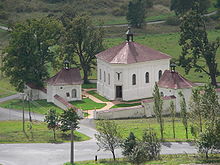Trinity Chapel (Andělská Hora)
The Chapel of the Holy Trinity (Czech Kostel Nejsvětější Trojice ) on the outskirts of the Czech community Andělská Hora (German Angel House ) is a protected architectural monument. An important pilgrimage destination since the late Middle Ages, today's chapel was built between 1698 and 1712 according to plans by the architect Giovanni Battista Alliprandi in place of a previous wooden building and converted into a burial church in the 19th century. There was a well with a healing spring nearby.
history
The chapel is on a road that was once an important trade route from Donawitz to Buchau. Since the late Middle Ages, one of St. Wooden chapel dedicated to the Virgin, first mentioned in writing in 1393. It housed a Gothic Madonna sculpture, which was later venerated as the Holy Trinity . Next to the church by the old linden tree was a miraculous healing spring to which pilgrimages took place.
There was a hermitage south of the chapel. The religious community is said to have brought the daughter of the landowner Ludmilla into being around 1500. During the occupation of Engelhaus by the Hussites , the chapel was burned down and only rebuilt after the end of the Hussite Wars. According to legend, the miraculously preserved Madonna was found in the ashes. The lord of the castle Heinrich III. von Plauen gave the chapel a new portrait of the Madonna. In his will of April 27, 1514, he founded a perpetual annual mass for himself and his family in front of the altar. The image of grace was destroyed during the Reformation .
In 1646 the master carpenter Georg Kreil received 36 Kreuzers for the repair of the vestibule of the wooden chapel. However, the small chapel could no longer contain the growing mass of pilgrims. In gratitude for the birth of a male heir, the then owner of the estate, Count Hermann Jakob Czernin von Chudenitz, had a new baroque chapel built between 1698 and 1712 according to the plans of the Prague architect Giovanni Battista Alliprandi . Another story tells of a vow the count kept after an accident. Due to a lack of money, the building was only completed after 14 years. The cost was 1242 guilders.
On November 28, 1730, the Brotherhood of the Order of the Holy Trinity was founded, to which the Archbishop of Prague Daniel Joseph Mayer von Mayern entrusted the administration of the Trinity Chapel on May 24, 1732 . The majority came from the ranks of the nobility and higher clergy. Until 1736 the pastor of Engelhaus Martin Lappat was the brotherhood's first superior.
A church service was held every second Sunday of the month, as well as a holy mass four times a year for the numerous pilgrims. In the course of further construction work under Count Ludwig Hartig, the church also received a new magnificent organ in 1753. The walls and ceilings were designed by the Carlsbad artist Joseph Kramolín in 1783 . After the brotherhood was abolished by Joseph II, the pilgrimage church was closed and some of its furnishings and votive objects were robbed. The chapel was now the patron of the community. In the first half of the 19th century, the cemetery was moved to the chapel and the buildings were converted into a burial church.
After the Second World War, the freely accessible chapel was exposed to vandalism. Burglaries did enormous damage to her. The inventory was lost, including the art-historically valuable early baroque altar. With financial support from the Ministry of Culture of the Czech Republic, extensive reconstruction was carried out from 2004 to 2005. The reopening took place on July 8, 2006. Today the chapel serves as a cultural and social center with exhibition rooms.
description
The church has a single nave in the form of an equilateral triangle with beveled corners and a three-sided pyramid roof. The walls are each interrupted by three large windows and divided in the corners by massive pilasters. In the corners there were originally three rectangular entrance portals, two of which were walled in in the middle of the 20th century. The two preserved side chapels were placed on the axes of the surrounding wall.
Furnishing
The ceiling was originally decorated with a fresco of the Holy Trinity by the painter Joseph Kramolin from 1783. In 1905 it was painted over. The no longer preserved early Baroque altar was created by the sculptor Franz Preiss around 1710. It was surrounded by statues of the Holy Trinity. Above the main entrance was a scene of Christ crucified in the Trinity. Fragments of the original paintings have been preserved on the walls.
Peal
Two bells originally hung in the church's bell tower. An old inventory from 1737 lists three bells. The larger and older bell with the name of Count Humprecht Czernin from 1673 may have come from the previous building. More bells hung in the side chapels.
Web links
Individual evidence
- ^ Andělská Hora | CZECH-BAVARIAN GEOPARK. Retrieved March 30, 2020 .
- ↑ Jaroslav Vyčichlo: Andělská Hora - kostel Nejsvětější Trojice | Památky a příroda Karlovarska. Retrieved March 30, 2020 .
- ^ Hugo Rokyta: Bohemia . Vitalis, 1997 ( google.de [accessed March 30, 2020]).
- ^ Announcements from the North Bohemian Excursions Club . Der Club, 1898 ( google.de [accessed March 30, 2020]).
- ↑ Elbogner Kreis: 15 . Ehrlich, 1847 ( google.de [accessed March 30, 2020]).
Coordinates: 50 ° 12 ′ 1.6 ″ N , 12 ° 57 ′ 29.1 ″ E


